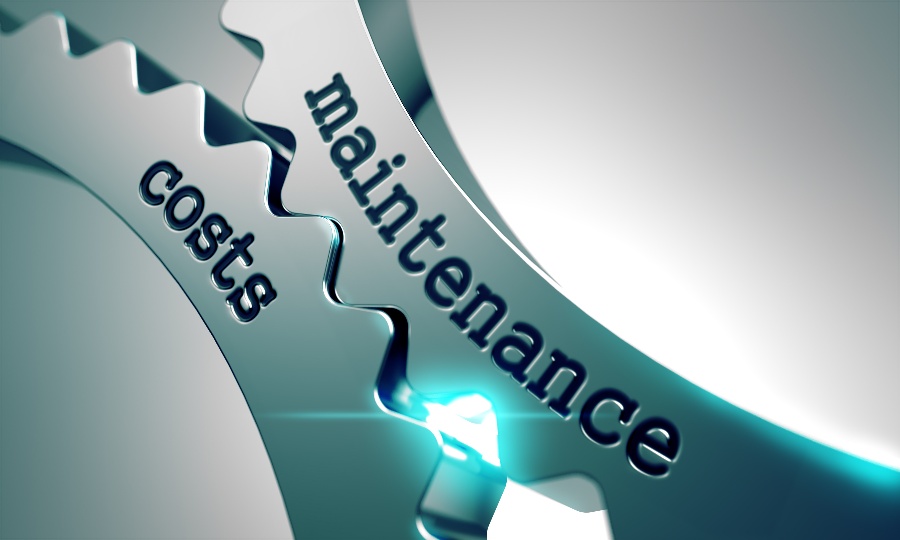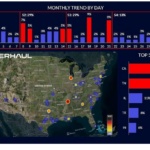You can reduce your fleet maintenance costs through safety, repair and efficiency measures – all of which GPS fleet tracking software can streamline.
- Fleet capital and repair costs significantly more than administration and licensure.
- To calculate your fleet maintenance costs, add up each fleet vehicle category’s capital, repair, administration and licensing costs.
- Most of the best ways to reduce fleet maintenance costs pertain to smarter, safer driving practices and choosing GPS fleet tracking software.
The costs of operating a fleet of vehicles run far beyond the purchase prices. Managing a whole fleet of business vehicles is a sizable cost to your company. Although your fleet is vital for timely service, your operations will result in far less profit if your vehicles are rapidly draining your bank account. The good news is that lowering your fleet maintenance costs is indeed possible, especially with GPS fleet tracking and telematics systems.
Types of fleet maintenance costs
Common fleet maintenance costs include capital expenditures, repairs, depreciation, administration and licensing. The sum of these costs is often referred to as the fleet’s total cost of ownership (TCO). A high TCO can indicate a need to replace outdated vehicles or switch to fleet leasing.
- Capital: Anytime you spend money on your fleet, there’s the possibility that other types of spending would have led to a greater return on investment. This potential ROI gap is the hidden cost of obtaining fleet capital. You can counter it by increasing your fleet size, as the larger your fleet is, the better pricing deals you can negotiate with dealerships. Additionally, maintenance for larger fleets can be more efficient.
- Repairs: Fleet repair costs typically increase significantly every year. You can limit the rate at which your repair costs increase by scheduling regular vehicle maintenance appointments even when no fixes are necessary. It is important to find a repair provider who does quality work, as shoddy repairs can shorten your vehicles’ lifetime.
- Depreciation: Although you can’t prevent depreciation entirely, you can slow it down. There are industry-standard rates for depreciation based on vehicle age, but careful, regular repairs can keep your vehicles in good enough condition to offset depreciation. You can also choose vehicles with lower depreciation rates, as the rates vary for different vehicle categories.
- Administration and licensing: Though not as closely related to your car or truck’s physical condition as other parts of your TCO, administration and licensing can cost a pretty penny. These formalities vary in cost by fleet and vehicle type, as licensure isn’t needed for dry-van and refrigerated trailers.
The importance of calculating your fleet maintenance costs
Your TCO can help you determine when it’s time to replace vehicles or switch from buying to leasing. TCO calculations are also crucial to efficient fleet performance: The fewer repairs required because of your drivers’ road habits, the lower the impact on your revenue stream.
In other words, if you regularly calculate your TCO, you’ll better understand when and how to modify your business’s and drivers’ practices to maximize your profit.
Here are some tips to reduce your fleet maintenance costs
Although fleet maintenance costs are inevitable, they don’t have to be sky-high. Here are some best practices for fleet maintenance that can reduce your TCO:
1. Install GPS fleet tracking software.
The best GPS fleet tracking software gives you constant access to real-time data about your drivers’ fuel use, locations and safety. It also alerts you to any concerning events, such as aggressive driving or vehicle theft. This comprehensive and constant overview of your fleet’s performance can help you pinpoint and resolve inefficiencies to lower your TCO.
2. Use fewer vehicles.
If you have the capacity to spread the same number of drivers over a smaller fleet, this is a surefire way to cut your costs. Of course, you shouldn’t eliminate so many vehicles that your drivers are rushing between stops on their routes and thus driving unsafely.
3. Take shorter routes.
If your fleet doesn’t have GPS routing, you should implement this direction technology ASAP. GPS routing calculates the fastest route to your drivers’ destinations based on real-time traffic data, saving your team time and thus money. With less time on the road comes less wear and tear that adds to your depreciation and repair costs.
4. Upgrade your parts.
Fleet managers often swap out their vehicles’ old parts for new ones to make their fleets more efficient, which has the secondary effect of reducing fleet costs. The upfront cost of part replacement comes with more efficient, higher-tech vehicle operation that can substantially reduce the frequency of costly repairs.
5. Prioritize smart fuel use.
Fuel is among your biggest costs in maintaining a fleet. It’s an inevitable expense, but you can minimize it in two ways. Firstly, aim for a larger average value of miles per gallon among your fleet. The vehicle part upgrades can help on this front, as can training your drivers in fuel-efficient practices.
Second, in your fuel efficiency training, you should discourage idling and hard braking. You should also encourage your drivers to turn off their ignition and remove their keys at gas stations and rest stops. Although each instance of these gas-saving tactics only conserves a small amount of fuel, your cumulative fuel savings could be substantial.
6. Replace aging vehicles.
At some point, driving old vehicles costs more than the (admittedly high) price tag of obtaining new ones. Vehicles that require frequent repairs and have less efficient gas tanks result in extra fleet maintenance costs – perhaps higher than the cost of obtaining new vehicles. Financial forecasting can help you decide when to replace your vehicles and with which vehicles to replace them.
7. Balance acquisition costs and depreciation.
Depreciation, though a somewhat abstract concept, matters from the moment you buy a new vehicle. Some vehicles depreciate so quickly that their lower purchase price may mask higher long-term costs.
For example, let’s say you choose a $12,000 vehicle with a 40% annual depreciation rate over a $15,000 vehicle with a 20% annual depreciation rate. In time, the former vehicle’s quicker depreciation will render its costs higher than the latter. As such, you should consider all relevant financial metrics when buying new vehicles to keep your TCO low.
8. Lower your off-the-road costs.
Fleet maintenance isn’t solely about your vehicles. It’s also about where you store them and where you go to oversee your non-road operations; your office and warehouse rent both count as fleet maintenance costs. Lowering these and other overhead costs – or perhaps eliminating certain offices and storage spaces entirely – is an easy way to cut your long-term TCO.
9. Implement driver scorecards.
Driver scorecards help to keep your fleet safe on the road, because they assess your team’s road habits such as speed and seatbelt use. They also have applications in fleet optimization and productivity. As such, driver scorecards are ideal across the board for lowering your team’s operational costs and thus your TCO.
Source: www.businessnewsdaily.com





